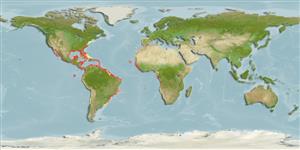分类 / Names
俗名 | 同种异名 | Catalog of Fishes(属, 种) | ITIS | CoL | WoRMS | Cloffa
Elasmobranchii
板鳃亚纲 (鲨鱼与 鱼) (sharks and rays) >
Carcharhiniformes (Ground sharks)
白眼鮫目 (Ground sharks) >
Carcharhinidae (Requiem sharks)
白眼鮫科 (Requiem sharks)
Etymology: Negaprion: negatus (L.), to deny; prion (Gr.), saw, referring to lack of saw-like serrations on teeth cusps (See ETYFish); brevirostris: brevis (L.), short; rostrum (L.), snout, referring to short, flat and broadly rounded snout (See ETYFish).
More on author: Poey.
Environment: milieu / climate zone / depth range / distribution range
生态学
海洋; 半咸淡水 礁区鱼类; 海洋洄游的 (Ref. 51243); 深度上下限 0 - 92 m (Ref. 244). 亞熱帶的; 45°N - 33°S, 114°W - 14°E (Ref. 55192)
Western Atlantic: New Jersey, USA to southern Brazil, including the Gulf of Mexico, the Bahamas, and the Caribbean; also in Gulf of Mexico (Ref. 26938). Northeast Atlantic: Senegal, Côte d'Ivoire and probably wide-ranging off West Africa, but this requires confirmation. Eastern Pacific: southern Baja California, Mexico and the Gulf of California to Ecuador.
西大西洋: 美國的紐澤西到巴西南部, 包括墨西哥灣,巴哈馬與加勒比海; 也在墨西哥灣.(參考文獻 26938) 東北大西洋: 塞內加爾, 象牙海岸與可能廣泛分佈外海的非洲西方部, 但是這需要證實。 東太平洋: 墨西哥的下加利福尼亞南部與加州灣到厄瓜多。
Length at first maturity / 大小 / 重量 / 年龄
Maturity: Lm ?, range 239 - ? cm
Max length : 340 cm TL 雄鱼/尚未辨别雌雄; (Ref. 26938); common length : 240 cm TL 雄鱼/尚未辨别雌雄; (Ref. 5217); 最大体重: 183.7 kg (Ref. 40637); 最大年龄: 25 年 (Ref. 31395)
A brownish shark with yellow overtones but no conspicuous markings. Large second dorsal fin nearly same size as first dorsal (Ref. 26938).
一褐色的鲨鱼有黄色的弦外之音但是没有显着的斑纹。 大的第二背鳍鳍几乎与第一背鳍大小相同。 (参考文献 26938)
Occurs on continental and insular shelves, frequenting mangrove fringes, coral keys, docks, sand or coral mud bottoms, saline creeks, enclosed bays or sounds, and river mouths. May enter fresh water. Occasionally moves into the open ocean, near or at the surface, apparently for purposes of migration. May rest motionless on the bottom (Ref. 9710). May occur singly or in small groups. Feeds mainly on fish but also takes crustaceans and mollusks. Viviparous, with 4 to 17 young in a litter. Size at birth 60 to 65 cm. Has been involved in several attacks on people. Meat is utilized for human consumption, hides for leather, fins for shark-fin soup base, liver oil for vitamins, and carcasses for fish meal. Marketed fresh, dried-salted and frozen (Ref. 9987).
生活于被常常聚集于红树林穗缘,珊瑚钥匙,船坞,沙子或珊瑚泥底,咸度小溪,封闭的海湾或声音 , 与河口的大陆架与岛屿棚。 可能进入淡水。 偶然地移入开放性海域, 接近或在水表面, 显然地对于迁移的目的。 五月在底部上让不动的休息。 (参考文献 9710) 可能单独出现或形成小群鱼群。 主要吃鱼也捕食甲壳动物与软件动物。 胎生的, 有四个到 17 幼鱼在一胎。 出生时的大小 60 到 65 公分。 曾经关系到一些对人的攻击。 肉被供人类消费使用, 皮用做皮革,鳍用于鱼翅汤底,肝油用于维他命与残骸用于鱼粉。 在市场上销售生鲜地了, 乾燥盐腌与冷冻.(参考文献 9987)
Life cycle and mating behavior
成熟度 | 繁殖 | 产卵场 | 卵 | 孕卵数 | 仔鱼
Distinct pairing with embrace (Ref. 205). Viviparous, placental (Ref. 50449), with 5 to 17 embryos (Ref. 9253). Both male and female during precopulatory and courtship swim with body axes in parallel (Ref. 49562, 51112). During copulation, the pair performs coordinated swimming (Ref. 49562, 51112).西大西洋: 美國的紐澤西到巴西南部, 包括墨西哥灣,巴哈馬與加勒比海; 也在墨西哥灣.(參考文獻 26938) 東北大西洋: 塞內加爾, 象牙海岸與可能廣泛分佈外海的非洲西方部, 但是這需要證實。 東太平洋: 墨西哥的下加利福尼亞南部與加州灣到厄瓜多。
Compagno, L.J.V., 1984. FAO Species Catalogue. Vol. 4. Sharks of the world. An annotated and illustrated catalogue of shark species known to date. Part 2 - Carcharhiniformes. FAO Fish. Synop. 125(4/2):251-655. Rome: FAO. (Ref. 244)
世界自然保护联盟红皮书 (Ref. 130435: Version 2024-2)
人类利用
渔业: 商业性; 游钓鱼种: 是的
工具
特别资料
下载 XML
网络资源
Estimates based on models
Preferred temperature (Ref.
123201): 21.9 - 28, mean 25.6 °C (based on 714 cells).
Phylogenetic diversity index (Ref.
82804): PD
50 = 0.7500 [Uniqueness, from 0.5 = low to 2.0 = high].
Bayesian length-weight: a=0.00513 (0.00270 - 0.00973), b=3.10 (2.94 - 3.26), in cm total length, based on LWR estimates for this species & (Sub)family-body (Ref.
93245).
营养阶层 (Ref.
69278): 4.3 ±0.5 se; based on diet studies.
Generation time: 9.2 ( na - na) years. Estimated as median ln(3)/K based on 1
growth studies.
回复力 (Ref.
120179): 非常低的, 最小族群倍增时间超过14 年 (K=0.54(?); tm=12.7; tmax=25; Fec = 4-17; rmax = 0.012).
Fishing Vulnerability (Ref.
59153): High to very high vulnerability (73 of 100).
Climate Vulnerability (Ref.
125649): Very high vulnerability (76 of 100).
Nutrients (Ref.
124155): Calcium = 2.73 [0.51, 15.56] mg/100g; Iron = 0.307 [0.074, 0.937] mg/100g; Protein = 22.4 [20.0, 24.6] %; Omega3 = 0.145 [0.049, 0.381] g/100g; Selenium = 15.2 [4.5, 49.2] μg/100g; VitaminA = 29.7 [7.6, 116.9] μg/100g; Zinc = 0.449 [0.209, 0.900] mg/100g (wet weight);
